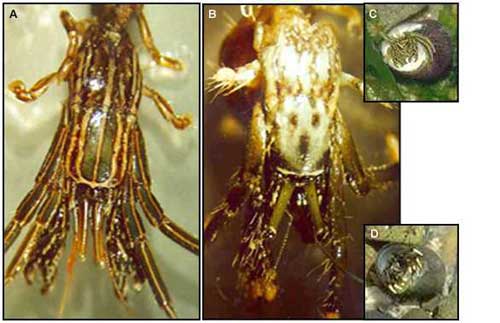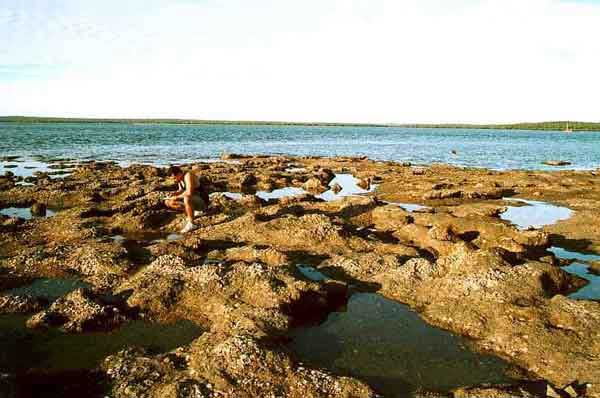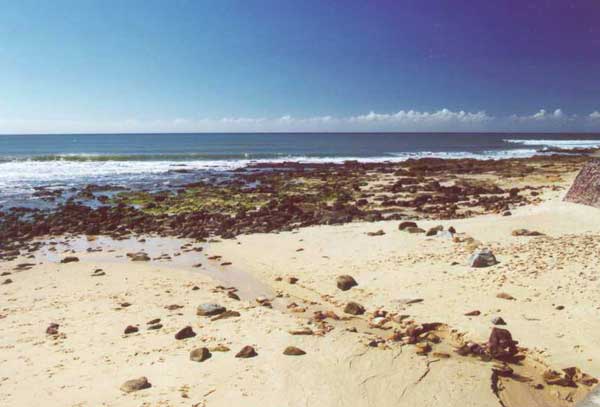What are Hermit Crabs?
Hermit crabs are relatively small crustaceans that, for the most part, require the use of empty gastropod shells in order to protect their soft and vulnerable abdomens. Approximately 1400 species are currently known to inhabit semi-terrestrial, intertidal, shallow water and deep ocean environments around the world (Lemaitre, pers. comm.) The striped-leg hermit crab (Clibanarius taeniatus) (Photo 1A) and yellow-footed hermit crab (Clibanarius virescens) (Photo 1B) can commonly be found on the rocky shores of Queensland. These hermit crabs inhabit shallow tide pools and can be seen balanced on rocks from low shore to the high intertidal mark. Where conditions are right, these hermit crabs may occupy the majority of empty snail shells1.

Photo 1. Two common hermit crabs of the Queensland coast. A (and C): the striped-leg hermit crab (Clibanarius taeniatus). B (and D): yellow-footed hermit crab (Clibanarius virescens). Photos by S.G. Dunbar and A. Kay.
Significance of Hermit Crabs
An awareness that biological changes can occur to coastal habitats and intertidal communities is important for coastal managers and developers. Equally important is a relatively easy, cost-effective mechanism by which changes can be predicted and monitored over time and over a large scale2. There is a long history of the use of marine invertebrates as indicators of the presence and intensity of pollution3. Increased abundance of the polychaete, Capitella capitata, for example, has been shown to indicate pollution from domestic outfalls45. Imposex in marine gastropods indicates the presence of the antifouling agent Tributyltin67. Mussels and oysters are often used to indicate lipid soluble toxins in marine environments89. Unlike gastropods, striped-leg and yellow-footed hermit crabs are unable to completely seal off the aperture of the shell during times of environmental stress, such as when seawater is diluted by freshwater. Indeed, field studies conducted along the Queensland coast (Photo 2) have found striped-leg and yellow-footed hermit crabs better indicators of changing intertidal conditions and community structure than snails, oysters or clams1011.

Photo 2. Surveying Turkey Beach, Queensland for the relative numbers of striped-leg and yellow-footed hermit crabs. Photo by S.S. Dunbar.
What causes Hermit Crab species to change?
Contaminants are often carried to coastal zones by stormwater. This stormwater would naturally absorb into the ground if it were not for hard, unnatural surfaces that are a result of urbanisation. Such surfaces include paved areas, roads and roofs, which all act to direct water runoff into stormwater drains and onto intertidal areas. In addition to carrying contaminants, large incursions of freshwater may also have ecological effects on inshore areas by severely depressing normal salinity levels. The striped-leg and yellow-footed hermit crabs have different physiological tolerances to reduced salinity10 and recent studies have found that striped-leg hermit crabs are more numerous where there is an influence of freshwater, while yellow-footed hermit crabs seem to favor areas where little or no freshwater flows onto the coast111. Therefore, changes in the relative numbers of these species over time can indicate unnatural freshwater flows and changes in salinity that may have ecological impacts.
Coastal areas where Hermit Crabs are best applied as indicators
Hermit crabs as indicators are ideally suited to coastal regions where intense development results in a range of coastal discharges such as untreated, or partially treated sewage, chemical effluent from industrial sources and stormwater runoff from residential and commercial areas. Stormwater runoff and unnatural freshwater flows, in particular, are of increasing importance in tropical regions12 and in areas where freshwater has previously been absent (see Photo 3).

Photo 3. Stormwater drains onto the intertidal zone. The path that stormwater takes onto the intertidal zone is clearly seen along this popular beach in Maroochydore, Queensland. What impacts stormwater has on inshore communities in Queensland is virtually unknown. Photo by S.G. Dunbar.
Considerations for measurement and interpretation
Sites for monitoring can be subdivided into survey sectors and surveyed at regular intervals (3 to 6 months). Teams of two to four people are assigned a sector in which to make collections of hermit crabs and each person is assigned a subsection of their sector. Collectors gather a minimum of 30 visible (not under rocks or algae) hermit crabs within a 1 m reach of their position in shallow tidepools, placing each specimen into a small bucket. Collections take about 20 minutes, at the end of which, each bucket is emptied into a sorting tray containing enough seawater to cover shells. This allows each species to be identified and the numbers of hermit crabs to be counted and recorded on data sheets. After counts have been made, all hermit crabs are returned to the pools from which they were taken. Field conditions may dictate the appropriate amount of time for collection activities (duration of low tide, season, temperature, etc.), but in most cases, a three hour session is considered the maximum. This method and time limit is appropriate for people in the age range from eight to seventy years old and assumes no prior knowledge about the scientific methods of field sampling1.
If a small group of collectors has been well trained and are familiar with the species to be counted, collectors can record data as observations are made. Although this modification to the recording process will reduce field time, care must be taken to ensure that the methods used are standardized between individuals. Depending on the number of collectors, several hundred to thousands of data entries can be made during a single day of field work11011.
Existing information and data
The most current data on the use of striped-leg and yellow-footed hermit crabs as tools for monitoring changes in inshore areas have been compiled in the Rocky Reef Watch Project Report1.
Contributor
Steve Dunbar, Loma Linda University, CA
- Kay, A. and Coates, M. 2002. Rocky Reef Watch Project Report 2000 – 2002. Queensland Parks and Wildlife Service, Brisbane. ↩ ↩ ↩ ↩ ↩
- Ward, T. J. 2000. Indicators for assessing the sustainability of Australia’s marine ecosystems. Marine and Freshwater Research. 51: 435-446. ↩
- Reish, D. J. 1972. The use of marine invertebrates as indicators of varying degrees of marine pollution In: Marine Pollution and Sea Life. (M. Ruivo, Ed.) Fishing News (Books) Ltd.: London, England. pp.203-207. ↩
- Filice, F. P. 1954. An ecological survey of the Castro Creek area in San Pablo Bay. Wasmann Journal of Biology. 12(1): 1-24. ↩
- Bellan, G. 1967. Pollution et peuplements bénthiques sur substrat meuble dans la region de Marseille. Deuxiéme partie. L’ensemble portuaire marseillais. Revue Internationale d’Océanographie Medicale. 8: 51-95. ↩
- Bright, D. A. and Ellis, D. V. 1989. A comparative survey of imposex in north-east Pacific neogastropods (Prosobranchia) related to tributyltin contamination, and choice of a suitable bioindicator. Canadian Journal of Zoology. 68: 1915-1924. ↩
- Nias, D. J., McKillup, S. C., and Edyvane, K. S. 1993. Imposex in Lepsiella vinosa from Southern Australia. Marine Pollution Bulletin. 26(7): 380-384. ↩
- Chen, H.-Y., Chuang, M., and Lee, C.-L. 1996. Use of oyster, Crassostrea gigas, and ambient water to assess metal pollution status of the charting coastal area, Taiwan, after the 1986 green oyster incident. Chemosphere. 33(12): 2505-2532. ↩
- Al-Madfa, H., Abdel-Moati, M. A. R., and Al-Gimaly, F. H. 1998. Pinctada radiata (Pearl Oyster): a bioindicator for metal pollution monitoring in the Qatari waters (Arabian Gulf). Bulletin of Environmental Contamination and Toxicology. 60: 245-251. ↩
- Dunbar, S. G. 2002. Respiratory, Osmoregulatory and Behavioural Determinants of Distribution of Two Tropical Marine Hermit Crabs. PhD Thesis. School of Biological and Environmental Sciences, Central Queensland University. Pp. 322 ↩ ↩ ↩
- Dunbar, S. G., Coates, M., and Kay, A. 2003. Marine hermit crabs as indicators of freshwater inundation on tropical shores. Memoirs of Museum Victoria. 60 (1): 27 – 34. ↩ ↩ ↩
- Dunbar, S. G. 2002. Surviving the storm. Queensland Regional Ripples; Marine and Coastal Community Network. 8 (4): 6. ↩


